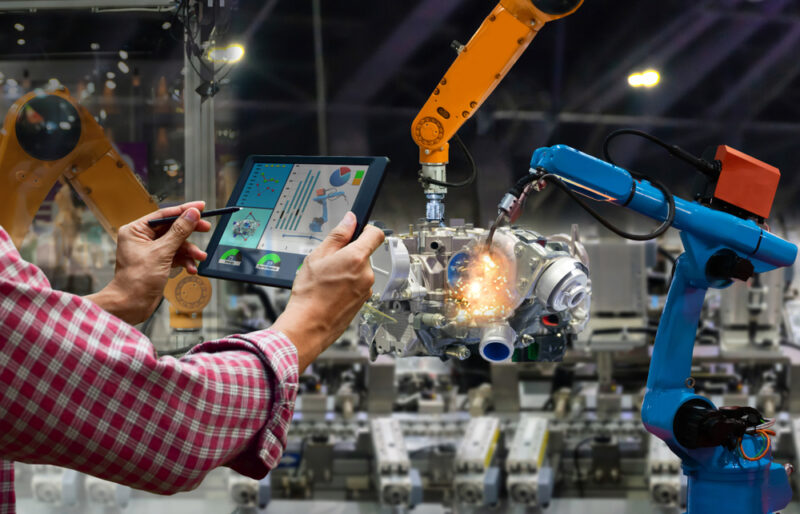Although the American economy is highly diversified, the manufacturing industry is primarily responsible for propelling the United States to its status as the world’s largest economy. Even today, the sector remains a driving force for innovation. Manufacturing has produced roughly 90 percent of U.S. patents and is responsible for over 75 percent of private-sector research and development, dwarfing all other industries.1, 4 Nevertheless, manufacturing in the United States has hit a roadblock. Although the industry is popularly associated with manual labor, manufacturing now requires workers with advanced science, technology, engineering, and mathematics (STEM) skills. Since modern production relies heavily on automation, robotics, and cutting-edge materials, companies are desperate for professionals who can help them revolutionize their processes from research and development for new products to maximizing assembly efficiency. Firms also need skilled technical workers to operate increasingly complex machinery, offering many opportunities for those without a traditional university education. With manufacturing continuing to evolve, an estimated 600,000 jobs in the field remain unfilled, and studies estimate that the sector will have over 2 million openings by 2022.2 For STEM workers looking to apply their skills to a rapidly-changing sector, the manufacturing industry provides countless job options for those looking to be a part of the production revolution.
Manufacturing Now
Manufacturing in the United States is undergoing a renaissance. Although the sector dipped to 11.5 million jobs in 2010, by 2016, employment rebounded to 12.3 million.3 However, job numbers don’t tell the full story, as output has continued to grow regardless of employment. Compared to twenty years ago, workers now produce almost 50 percent more.3 New technologies, especially automation and robotics, have driven rapid growth in output. Over the past decades, American manufacturing has shifted from a focus on economies of scales and assembly lines to a rapid technological arms-race. For American firms to stay competitive, investing in technology and data analytics is a must.
Several significant trends are driving manufacturing innovation worldwide, all of which depend on STEM professionals. Foremost is the proliferation of advanced robotics, artificial intelligence (AI), and machine learning. From 2013 to 2014, industrial robots in use increased from 1.2 to 1.5 million, and the use of AI and machine learning grew from 0.9 to 36 billion dollars—a growth rate exceeding 500 percent.5 AI completes vital manufacturing tasks such as simulating products to predict performance in different environments and monitoring production conditions, but its applications continue to grow. Currently, AI-driven product simulation reduces the number of physical trials and design iterations, getting products to the market faster. Certain AI programs can reduce design iterations by 70 percent, allowing engineers to meet regulatory and customer requirements with fewer design cycles.8Another major shift is in selecting materials as scientists develop novel alloys and materials. Such materials may have resistance to harsh environments, enabling performance everywhere from the ocean floor to outer space. Other innovations include drastically reducing weight while maintaining structural integrity, ideal for infrastructure, automobile, and aerospace applications. The proliferation of a wide range of new materials has also produced a need to crunch massive amounts of data to determine which material best suits a specific application.5 As a result, manufacturers will begin relying more on augmented reality to select materials, eliminating the need for engineers to sift through vast lists manually.
Alongside these pioneering technologies, manufacturers will also increase their use of high-performance computing. With an exponentially expanding volume of data, manufacturing firms need the high-performance computing capabilities to tackle everything from predictive analytics to simulation.
Finally, the shift to digital has increased manufacturers’ need for improved cybersecurity protocols. In the modern internet age, manufacturers are frequently vulnerable to cyberattacks. As a result, firms are seeking computer science professionals to protect their innovations from digital thieves and maintain their systems’ integrity.
The Production Renaissance and Your STEM Career
As firms rush to implement new technology, the manufacturing sector is looking to hire countless STEM workers. Not only are there a wide range of opportunities, but they also pay well. In the U.S., the average manufacturing worker makes a salary about 20 percent higher than full-time service sector positions.2 Studies indicate that manufacturing jobs requiring STEM expertise have a pay premium that increased from 12 to 21 percent.6 A Deloitte study estimated that manufacturing will need to fill 2 million STEM-oriented jobs over the next decade.6
Employers in manufacturing are seeking a wide range of STEM skills. For example, manufacturers are now seeking employees with computer science skills, particularly in computer-aided design (CAD). A report by Georgetown University anticipated employers would look towards employees with cognitive rather than manual labor skills, emphasizing abilities like communication and analytics.7 While the common thread permeating manufacturing sector hires is STEM, employers are looking for experts across many fields and with diverse educational backgrounds. As firms seek workers to operate and maintain advanced machinery, a wide variety of skilled technician positions are opening for those without traditional university degrees. These jobs include professions such as industrial machinery mechanics and maintenance workers, a career reporting a whopping 13% annual growth rate.9 Like many other technical positions, this job requires only a high-school diploma with most training done on-the-job or through apprenticeships.
Putting It All Together: Modern Manufacturing
As new technologies continue to revolutionize manufacturing, the sector has continued to produce innovations at a rate that outpaces any other field. The production juggernaut of manufacturing is no longer solely reliant on untrained labor. With a technological arms race driving global competition, manufacturers desperately need STEM professionals to fill complex jobs. For STEM workers from various fields and educational backgrounds, manufacturing offers countless job options with high salaries and a chance to pioneer new technologies.
Are you an employer seeking skilled workers in science, technology, engineering, and math (STEM), or a jobseeker in STEM looking for your career’s next step? AllSTEM Connections can help. Visit our website at https://www.allstemconnections.com/.
- https://www.gray.com/insights/strategies-to-stimulate-growth-in-stem-jobs-to-meet-manufacturing-industry-needs/
- It’s Time to Talk About the Misconceptions of Manufacturing | Official Apple Rubber Blog
- https://www.brookings.edu/blog/techtank/2016/06/02/how-technology-is-changing-manufacturing/
- https://thebossmagazine.com/stem-education-supply-chain/
- https://cerasis.com/manufacturing-technologies/
- https://blog.gppcpa.com/blog/enewsletters/article/the-paramount-importance-of-stem-in-todays-manufacturing-world
- https://remakelearning.org/blog/2014/06/11/dont-overlook-manufacturing-as-a-stem-career/
- https://www.monolithai.com/
- https://www.bls.gov/ooh/installation-maintenance-and-repair/industrial-machinery-mechanics-and-maintenance-workers-and-millwrights.htm





